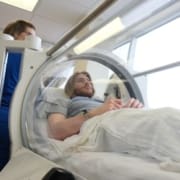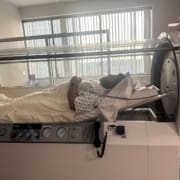How Hyperbaric Oxygen Therapy Effectively Treats Radiation Tissue Injury
Hyperbaric oxygen therapy has been the subject of medical studies for decades, and research strongly suggests that it’s an effective treatment for declining mental ability and some physical ailments.
One study from the National Baromedical Research Foundation explored using hyperbaric oxygen therapy for radiation tissue treatment, observing results over several years.
The Study On HBOT For Radiation Tissue Treatment
The study aimed to determine the validity of using hyperbaric oxygen therapy for radiation tissue treatment. Doctors have used the hyperbaric chamber to treat delayed radiation injuries for over 30 years. This research team, led by Dick Clarke, president of the National Baromedical Research Foundation, sought to determine how much of an impact it could have on late radiation tissue injury over five years.
Though radiation therapy has helped control malignant diseases for years, tumor treatments can damage healthy tissue and create late-stage skin injuries, which hyperbaric oxygen has treated successfully in past studies. Tissue damage from carbon monoxide poisoning and radiation treatment is common and often requires extensive surgery to treat. Some of the radiation’s late effects on normal tissue (LENT) include obliterative endarteritis, local hypoxia, and mortal injuries.
Clarke’s study into hyperbaric oxygen therapy for radiation tissue treatment sought to move beyond the past use of hyperbaric chambers to manage radiation injuries like mandibular osteoradionecrosis. Based on a presumed common underlying pathophysiology of LENT regardless of its location in the body, this study aimed to evaluate the effectiveness of hyperbaric oxygen therapy on specific sites.
The study began with eight components, seven of which involved evaluating established radionecrosis in several areas of the body, including:
- Colon
- Gyn
- Larynx
- Mandible
- Skin
- Rectum
- Bladder
The final component sought to determine whether hyperbaric treatment could prevent late radiation injury in tissue. However, the research team closed one of the components when an outside statistical analysis supported shutting down that particular arm.
To conduct the study, the research team performed both hyperbaric oxygen therapy and a sham procedure on participants with radiation injuries and tracked the results in the following years.
Eligibility Criteria For HBOT Research For Radiation Damage
After determining the above areas of study, the research team sought participants with pre-existing medical conditions in the target regions. To broaden the study’s range, the team opened enrollment to children, adults, and elderly adults of all sexes. However, the study forbade willing participants without a relevant medical condition from the experiment and those that matched the research team’s exclusion criteria. The inclusion criteria included those participants with such conditions as:
- Constipation or Diarrhea
- Cramping and Pain
- Endarteritis
- Fistula
- Hemorrhage
- Hypocellularity
- Hypovascularity
- Mucosal Thickening
- Obstipation
- Obstruction or Stricture
- Perforation
- Tenesmus
- Tissue Hypoxia
- Ulceration
- Vomiting
- Wall Changes
To narrow the study’s focus, the researchers implemented a set of exclusion criteria that applied to all potential participants, including those who met the inclusion criteria. The exclusion criteria focused on those who:
- Had previously documented ejection fraction less than 35%
- Had a history of seizures into adulthood (childhood febrile seizures were acceptable)
- Were unable to follow the research team’s instructions
- Were unable to perceive their location, the time of day, or their identity
- Needed a mechanical ventilator (immediately [1-5 days] post-operative patients were allowed to participate)
- Had pre-existing pulmonary blebs or bullae
- Displayed cardiovascular instability
- Were participating as a subject in a separate medical or biomedical research project at the time. Those who had previously participated in studies were allowed to enroll in this study only if sufficient time had passed to rid their bodies of any investigational agent.
- Were pregnant
- Had reactive airway disease
- Had an untreated pneumothorax
The Design Of The HBOT Study
Clarke’s interventional study brought in 226 participants and studied them using two research arms. The first arm was the hyperbaric oxygen therapy (Group 1), which the team administered at 2.0 Atmospheres Absolute (ATA). The second arm was the sham trial (Group 2), which required patients to receive hyperbaric treatment at 1.1 ATA, the standard weight for normal atmospheric pressure.
The research team randomly determined which patient received which treatment type. However, because they used a crossover assignment intervention model, each enrollee receiving the sham treatment also received actual hyperbaric oxygen treatment. The team also used double-blind masking to ensure they approached the study with as little bias as possible.
The researchers finished their primary outcome measures on Aug. 2011.
Expectations From The Study
The primary outcome measure used the SOMA (Subjective, Objective, Management, Analytic) scale to determine LENT’s effects on patients after treatment at certain intervals. The team followed up with participants three months, six months, one year, and five years after their initial hyperbaric oxygen therapy for radiation tissue treatment to chart progress and provide additional treatment if necessary.
Based on each participant’s recovery rate, they fell into one of five categories:
Healed: For participants who had completely recovered from the injury that the hyperbaric oxygen therapy treated.
Significant Improvement: For participants who saw their lesions reduced by more than 50%.
Modest Improvement: For participants who saw their lesions reduced by less than 50%.
Not Improved: For participants whose lesions stayed the same size following treatment.
Other: For participants with irregular injury development. For example, if a patient’s lesions shrunk and regrew or progressed following treatment.
The researchers planned to update the participant’s status at each time checkpoint. Their primary purpose for this study was to evaluate the use of hyperbaric oxygen therapy as an effective treatment for radiation tissue ailments. Ideally, every patient would reach the “healed” or “significant improvement” stage by the five-year threshold.
Results Of The Study
After initial treatment, the mean SOMA-LENT score improved in both Groups 1 and 2. Group 1 produced a lower mean (p = 0.0150) and showed improvement nearly twice as great as that of Group 2 (5.00 vs. 2.61, p = 0.0019). Participants in Group 1 also responded to clinical assessment in greater numbers than in Group 2.
The study also sought to measure participants’ overall quality of life, specifically as it applied to bowel bother subscale. Here, Group 1 again scored higher than Group 2. It’s worth noting, however, that the research team discarded the differences between the two groups after Group 2 received the same treatment as Group 1.
HBOT Study Conclusions
Based on this study, the research team concluded that hyperbaric oxygen therapy for radiation tissue treatment effectively improves the healing responses of patients with refractory radiation proctitis. The study also measured increased bowel-related quality of life.
Additional Read: 5 Ways Hyperbaric Oxygen Therapy Can Change Your Life
Research Locations
The study took place across the following seven healthcare institutions, which spanned five different countries:
- Instituto Nacional de Cancerologica: Mexico City, Mexico
- Istanbul University Medical Center: Istanbul, Turkey
- Palmetto Health Richland Hospital: Columbia, South Carolina, United States
- Royal Hobart Hospital: Hobart, Tasmania, Australia
- University of Pretoria Medical Center: Pretoria, South Africa
- University of Stellenbosch: Cape Town, South Africa
- Wesley Medical Center: Brisbane, Queensland, Australia
National Baromedical Services was a sponsor and collaborator for this study.
Hyperbaric Oxygen Therapy in Other Studies
In addition to this study on hyperbaric oxygen therapy for radiation treatment, hyperbaric treatment has shown promise in various other applications. One of the most well-known and promising studies for hyperbaric oxygen was on how HBOT affects cognition and mental performance.
The study monitored one patient, an 81-year-old male with declining cognitive speeds and memory in addition to a pre-existing artery disease, over three months. During that time, the patient received five hyperbaric oxygen therapy sessions per week for a total of 60 by the end of the research period.
Each session lasted two hours, with 20 minutes dedicated to compression and decompression and the remaining time spent inside the hyperbaric chamber with the air pressure set to 101kPa. The patient received 100% oxygen in doses anywhere from 20 to 30 liters per minute for 20 minutes, with regular air returning once every five minutes.
The Results
After the study, the patient showed a 3.8% improvement in primary cognitive functions. They managed to process quicker, pay attention for longer, and have more executive function than before treatment. They also showed a 27% verbal memory increase.
The improved cognitive function aligned with the patient’s 43-52% blood flow increase before treatment. SPECT scans after the study also showed enhanced cerebral perfusion.
The study concluded that the patient improved their memory, processing speed, and cognition due to the improved blood flow and increased oxygen from the hyperbaric treatment. The study also encouraged additional studies into the effects of hyperbaric oxygen therapy, as the elements that helped the patient here could also help in other fields, including radiation tissue treatment.
Hyperbaric Oxygen Therapy for Radiation Tissue Treatment from NexGen Hyperbaric
NextGen Hyperbaric has used hyperbaric oxygen therapy for radiation tissue treatment for over 15 years. Our goal is to make cutting-edge medical solutions accessible to everyone. So, if you’re ready for the next generation of physical pain and cerebral function treatment, our clinic is the place for you.
Call NextGen Hyperbaric today at (888) 567-4302 to schedule an appointment or learn more about our hyperbaric technology.











